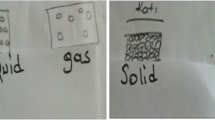Abstract
A growing area of interest in chemical education has been the research associated with conceptual understanding at the particulate level. This study investigated the views of 10 university chemistry lecturers, 85 pre-service chemistry teachers and 23 Secondary 3 (equivalent to Year 9) chemistry students about the particulate level of a chemical reaction, namely the heating of copper (II) carbonate. Four characteristic views were identified on the basis of their diagrammatic representations of particles. These were: (a) formation of intermediates; (b) formation of free particles (e. g., atoms or ions); (c) combination of a and b: formation of free particles (e. g., atoms or ions) first, and then intermediates; (d) no mechanism. Both the majority of the lecturers and the pre-service teachers held an identical view about the reaction mechanism, namely that the decomposition of copper (II) carbonate goes through a transition stage by forming intermediates. In contrast, even though the students were familiar with this reaction, about half of them naïvely believed that copper (II) carbonate broke up on heating and the particles recombined directly to form copper (II) oxide and carbon dioxide, the two observed products. About one-third of the students had neither any notion of how the atoms in the copper (II) carbonate lattice interacted and were rearranged in the reaction nor any concept of bond-breaking and reformation in a chemical reaction.
Similar content being viewed by others
References
Ahtee, M., & Varjola, I. (1998). Students' understanding of chemical reaction.International Journal of Science Education, 20(3), 305–316.
Ben-Zvi, R., Silberstein, J., & Mamlok, R. (1990). Macro-micro relationships: A key to the world of chemistry. In P. L. Lijnse, P. De Vos., W. Licht, & A. J. Waarlo (Eds.),Relating macroscopic phenomena to microscopic particles (pp. 183–197). Proceedings of a seminar at Utrecht Centre for Science and Mathematics Education, University of Utrecht, The Netherlands.
Briggs, J. G. R. (1997).Chemistry “O” Level (3rd ed.). Singapore: Longman.
Donnelly, J. F., & Welford, A. G. (1988). Children's performance in chemistry.Education in Chemistry, 25, 7–10.
Gabel, D. L. (1993). Use of the particle nature of matter in developing conceptual understanding.Journal of Chemical Education, 79(3), 193–194.
Johnstone, A. H. (1991). Why is science difficult to learn? Things are seldom what they seem.Journal of Computer Assisted Learning, 7, 701–703.
Laverty, D. T., & McGarvey, J. E. B. (1991). A “constructivist” approach to learning.Education in Chemistry, 28(4), 99–102.
Lee, K. W. L, Goh, N. K., & Chia, L. S. (1993, October). Enhancing conceptual understanding in Science instruction. Paper presented at the Teaching in Science Seminar, Faculty of Science, National University of Singapore, Singapore.
Lythcott, J.J. (1990). Problem solving and requisite knowledge of chemistry.Journal of Chemical Education, 67, 248–252.
Meheut, M., Saltiel, E., & Tiberghien, A. (1985). Students' conceptions about combustion (11–12 years old).European Journal of Science Education, 7(1), 83–93.
Noh, T., & Scharmann, L. C. (1997). Instructional influence of a molecular-level pictorial presentation of matter on students' conceptions and problem-solving ability.Journal of Research in Science Teaching, 34(2), 199–217.
Nurrenbern, S. C., & Pickering, M. (1987). Concept learning versus problem solving: Is there a difference?Journal of Chemical Education, 64(6), 508–510.
Sawrey, B. A. (1990). Concept learning versus problem solving: Revisited.Journal of Chemical Education, 67(3), 253–254.
Ten Voorde, H. H. (1990). On teaching and learning about atoms and molecules from a Van Hiele point of view. In P. L. Lijnse, P. De Vos., W. Licht, & A. J. Waarlo (Eds.),Relating macroscopic phenomena to microscopic particles (pp. 81–104). Proceedings of a seminar at Utrecht Centre for Science and Mathematics Education, University of Utrecht, The Netherlands.
Yarroch, W. L. (1985). Student understanding of chemical equation balancing.Journal of Research in Science Teaching, 22(5), 449–459.
Author information
Authors and Affiliations
Corresponding author
Rights and permissions
About this article
Cite this article
Lee, KW.L. Particulate representation of a chemical reaction mechanism. Research in Science Education 29, 401–415 (1999). https://doi.org/10.1007/BF02461601
Issue Date:
DOI: https://doi.org/10.1007/BF02461601



